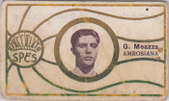
1aGiuseppe Meazza (ITA)
1929 Cioccolato Stagni Pettazzoni.
Much like Pelé versus Maradona, historians debate who was the best prewar footballer between Giuseppe Meazza and Matthias Sindelar (with a few votes thrown in for Leônidas, Andrade and Scarone). Meazza led Italy to victories at both the 1934 and 1938 World Cups, winning the Golden Ball award for best player at the former tournament. He is the fourth all-time scorer in Serie A, helping Inter Milan win three Serie A titles, as well as the second highest scorer for the Italian national team. Legend has it that during the 1933 season, Meazza made a bet with Gianpiero Combi, the legendary Juventus goalkeeper. Combi challenged Meazza, claiming that nobody, not even Meazza, could sidestep him to score a goal. Meazza accepted the challenge. In the next game between Inter and Juventus, Meazza dribbled through a series of defenders, including Luis Monti, before faking out Combi, dribbling past him, and scoring a tap-in goa...
| 
1bLeônidas da Silva (BRA)
1950 Tinghälls.
Brazil’s first superstar, Leônidas had speed, excellent technique and an incomparable elasticity. He was the player who patented, if not invented the bicycle kick, and was known in Brazil as “O Homen Borracha” (“the Rubber Man”). Leônidas was the high scorer and best player at the 1938 World Cup. At the club level, Leônidas won the Rio State Championship with each of Vasco da Gama, Botafogo and Flamengo.
| 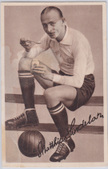
1cMatthias Sindelar (AUS)
1930s Fru Fru Yogurt.
Widely regarded as one of the top two prewar footballers, Matthias Sindelar was known for his fantastic dribbling ability and creativity. “Der Papierene” (“the Paper-man”) as he was known due to his slight build, led the Austrian national team to the top echelon of World football. The Wunderteam’s first important victory was a 5-0 win in 1931 over Scotland which had never before lost to a continental European team. Austria went on to defeat Hungary, Germany, Switzerland and Italy and narrowly lost to England in London, leading up to the 1934 World Cup where they fell to Italy in the semi-finals. Perhaps Sindelar’s greatest performance was in the 1933 Mitropa Cup (precursor to Champions League) in which Sindelar’s club, Austrian Vienna, defeated Iron Sparta, Italy’s dominant Juventus and Meazza’s Inter Milan. Sindelar scored the winning goal in the finals and was the joint top scorer of the tournament. The Wunderteam’s last ma...
|

1dArsenio Erico (PAR)
1934 Famosos Jugadores de Foot-Ball.
Argentine First Division’s highest goal scorer and the best Paraguayan footballer of all-time, Arsenio Erico was one of the best strikers of all-time. Erico led the league in scoring in each of 1937 (47 goals), 1938 (43) and 1939 (40), and led his club, Independiente, to league titles in 1938 and 1939. Before Erico’s goal total was revised upwards, he had been tied with Angel Labruna with 293 goals apiece, but amazingly Erico played in 183 matches fewer than Labruna.
| 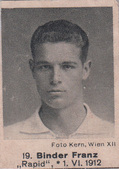
1eFranz Binder (AUS)
1933 Idis Fussball-Schokolade.
Franz “Bimbo” Binder is one of just six players to have scored more than 1000 goals in his career. Scoring 1006 goals in 756 matches, he holds the world record for highest strike rate at 1.33 goals per match. Binder led Rapid Wien to Austrian league titles in 1935, 1938, 1946 and 1948 and the German league title in 1941, while Austria was under German rule. Binder was the top goalscorer in Austrian Bundesliga in 1933, 1937 and 1838, and was the top goalscorer in first division Germany (called “Gauliga” between 1934 and 1945) in 1939, 1940 and 1941.
| 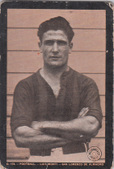
1fMonti, Luis (ARG/ITA)
1926 Cigarrillos Plus Ultra.
Luis Monti was a rugged and ruthless midfielder charged with marking the opponents’ center forward when his team was defending and being the main midfield playmaker when his team was on the attack. Monti is the only player to reach World Cup finals for two different teams, playing for Argentina in 1930 and Italy in 1934. Monti was tasked with marking Matthias Sindelar in the semi-final match of the 1934 World Cup in which Italy won 2-1. Playing for Juventus, Monti helped lead the Italian club to four consecutive league titles from 1932 to 1935.
|

1gGyorgy Sarosi (HUN)
1938 Camler’s Cigarettes.
Considered one of the best footballers of the prewar era, Dr. György Sárosi led his club to five Hungarian league titles between 1932 and 1941, and was the league’s top scorer for three seasons. Sárosi is best known for captaining Hungary to the 1938 FIFA World Cup finals where the team lost to Italy. Sárosi received the bronze ball for being the third top goal scorer of the tournament.
| 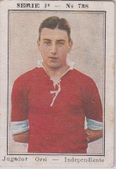
1hRaimundo Orsi (ARG/ITA)
1925 Cigarrillos Dolar.
Regarded as one of the best wingers to ever play in Italy, Raimundo Orsi first achieved success in Argentina, playing alongside Manual Seoane on Independiente and for the Argentine national team that won the silver medal at the 1928 Olympics. In Italy, Orsi won five consecutive league titles with Juventus and helped Italy win the 1934 World Cup.
| 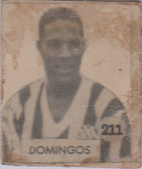
1iDomingos da Guia (BRA)
1948 Azes Da Pelota.
Nicknamed “the Divine Master,” Domingos is regarded as the best Brazilian defender of all time and the first to take risks and innovate his position. Domingos won league championships in his native Brazil, Argentina and Uruguay and rose to world prominence due to his performance at the 1938 World Cup. Seeing the brutality that some black players received inspired Domingos's extraordinary ability to dribble with the ball and avoid defenders, a trait which Brazilians would become famous for around the world.
|
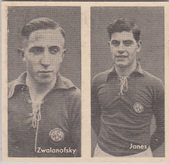
1jPaul Janes (GER)
1930 Greiling.
Paul Janes was one of the world’s best full backs of the WWII Era. Janes’ 71 caps, including 31 as Germany’s captain, remained a record for 30 years until broken by Uwe Seeler. A strong, intelligent player, Janes also displayed a flair, including spectacular bicycle kicks and free kicks, which was unusual for a defender.
| 
1kFrantišek Plánička (CZE)
1933 Star.
One of the greatest players in Czech history, Plánička possessed lightning-quick reflexes and excellent jumping ability that helped him compensate for being fairly undersized for a goalkeeper at 5’8”. Plánička appeared in 969 matches for Slavia Prague, helping establish that club as one of the best in Central Europe. He won eight Czech league titles, one Mitropa Cup and five Bohemian Cups (Czechoslovakia’s top domestic cup). IFFHS ranked Plánička as the ninth best goalkeeper of the 20th Century.
| 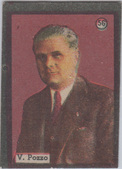
1lManager: Vittorio Pozzo (ITA)
1935 Ed il Balilla.
Vittorio Pozzo is the only manager to have won two World Cups. He oversaw the famous unbeaten run of the Italian side from 1934 until 1939. Pozzo created the tactical development of the ‘metodo’ formation. Later Pozzo evolved the formation into the Sistema (2-3-2-3 formation), which created a stronger defense.
|
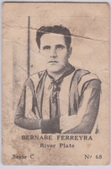
2aBernabé Ferreyra (ARG)
1933 Cigarrillos Ranchera.
One of the first stars in Argentina’s professional era, Bernabé Ferreyra was a legendary striker. One of only three South Americans to average more than one goal per game, he netted 206 goals in 197 games from the beginning of the professional era in 1931 to his retirement in 1939. So famous was his scoring that the Argentine newspaper Crítica even offered a prize to the first goalkeeper that played Ferreyra without receiving a goal. Ferreyra held the world record transfer fee in 1932 when he was transferred from Tigre to River Plate for 23000 pounds in 1932, a record that went unbroken for 20 years.
| 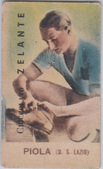
2bSilvio Piola (ITA)
1930s Ciccolato Zelante.
Silvio Piola is the highest goal scorer in Serie A history, with 274 goals, 49 ahead of anyone else. He is also the third highest goal scorer for the Italian national team, including 2 goals scored in the 1938 World Cup finals. Piola is the only player to have the honor of being the all-time Serie A top scorer of three different teams (Pro Vercelli, Lazio and Novara).
| 
2cOldřich Nejedlý (CZE)
1933 Star.
Top scorer of the 1934 World Cup, Oldřich Nejedlý is widely considered one of Czechoslovakia's greatest players and one of the top forward of the 1930s. He led Sparta Prague to four Czechoslovakian league championships during the 1930s and the Mitropa Cup in 1935. Playing for Czechoslovakia, Nejedlý scored 29 goals in 44 caps. In addition to winning the Golden Boot, he also won the Bronze Ball in the 1934 World Cup, as the third-best player in the tournament.
|
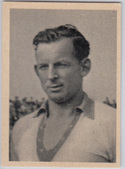
2dErnst Wilimowski (POL)
1950 Kosmos.
Ernst Wilimowski is unofficially credited with 1,175 career goals (including friendlies and unofficial matches). RSSFF credits Wilimowski with 554 official goals, making him one of the eight highest all-time goal scorers. Wilimowski was born in the country of Silesia which became part of Poland when he was 21. As a result of the German occupation, Wilimowski and the rest of the Polish national team all joined the German national team though he was persecuted by a Nazi ward leader and his mother was even placed in Auschwitz. Following WWII, the Communist Poland considered Wilimowski a traitor for playing for continuing to play for Germany and for German clubs. He was even disallowed from visiting the Polish National Team when they traveled to West Germany for the 1974 World Cup.
| 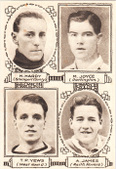
2eAlex James (SCO)
1921 All Sports (uncut sheet).
Another of the “Wembley Wizards,” Alex James was Arsenal’s main shot creator, fueling Herbert Chapman’s high-octane offense in the early 1930s. James’s passing and vision led to an unprecedented number of goals by the likes of Cliff Bastin, Ted Drake, David Jack and Jack Lambert and when James was healthy, there was no stopping the Gunners.
| 
2fAntonio Sastre (ARG)
1935 Leyes.
An all-around midfielder, Antonio Sastre was one of the first true playmakers of the prewar era. Sastre won two Argentine league titles with Independiente and three Brazilian league titles with São Paulo.
|

2gCarlos Peucelle (ARG)
1937 El Purrete.
One of Argentina's finest wingers in their history, Carlos Peucelle was a key player on the River Plate team of the 1930s. Nicknamed “Los Millonarios”, River Plate won Argentine league titles in 1932, 1936, 1937 and 1941. Peucelle had three goals in the 1930 World Cup.
| 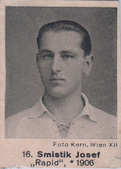
2hJosef Smistik (AUS)
1933 Idis Fussball-Schokolade.
Captain of the “Wunderteam,” Josef Smistik was one of the best center-halfs during the 1930s. Prior to 1934, Austria was undefeated when he started. Smistik was capped 39 times between 1928 and 1936. He was an integral member of Rapid Vienna during their glory years as one of the best European clubs, reaching the finals of the Mitropa Cup in 1927 and 1928 and winning the cup in 1930. Smistik was widely regarded as the best player in the 1930 tournament.
| 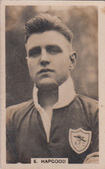
2iEddie Hapgood (ENG)
1936 John Scerri "International Footballers".
Left-back Eddie Hapgood was a key figure in the great Arsenal side of the 1930s that dominated English football like no club had done before. He won five league championships with Arsenal and captained both the Gunners and the English national team.
|
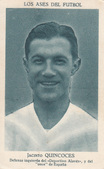
2jJacinto Quincoces (SPA)
1931 Los Ases Del Futbol.
Jacinto Quincoces, a central defender, was regarded as one of the best defenders of the prewar era. He was capped 25 times with the Spanish national team between 1928 and 1936.
| 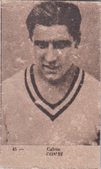
2kGianpiero Combi
1920s Editore Sconosciuto.
Gianpiero Combi was the keeper for the powerhouse Juventus team of the early 1930s. With Combi, Juventus won five Scudettos and finished as a Mitropa Cup semi-finalist four consecutive times. He formed a formidable defensive wall known in Italy as the “Trio Combi-Rosetta-Caligaris” for both Juventus and the Italian national team. He was the goalkeeper for the 1934 and 1938 World Cup-winning Italian teams. Combi kept a clean sheet for 934 consecutive minutes in the 1925-1926 season which remains still a Serie A record.
| 
3aCliff Bastin (ENG)
1929 DC Thomson "Footballers - Motor Cars".
The legendary coach Herbert Chapman spotted and recruited Cliff Bastin while he was playing for Exeter City at age 17. At Chapman’s Arsenal, Bastin was an integral part of the side that dominated English football in the 1930s, winning five First Division champships and two FA Cups during the decade. Despite his career being interrupted at its peak by World War II, Bastin scored 178 goals in 350 appearances for Arsenal.
|
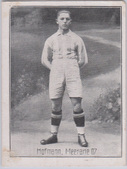
3bRichard Hofmann (GER)
1926 Greiling.
Prewar Germany’s best offensive prewar player, Richard Hofmann was a dominant striker in the late 1920s/early 1930s, scoring 24 goals in 25 matches for the national team. He was known for his thunderous shots with either foot. “King Richard” was at his peak in 1933 (age 27) when he received a lifetime ban from the national team after making an advertisement for a cigarette company (the Nazi party being anti-tobacco).
| 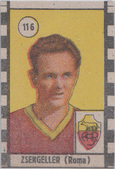
3cGyula Zsengellér (HUN)
1947 Nannina.
Gyula Zsengellér was the Hungarian league's top-scorer in five seasons (1938, 1939, 1943, 1944 and 1945) is the third-highest goal scorer of all-time in the league, with a total of 387 goals in 325 games. He is most famous for helping Hungary reach the 1938 World Cup finals and finishing second in the tournament to Leônidas for most goals scored.
| 
3dAntonin Puč (CZE)
1933 Star.
The all-time leading scorer for the Czechoslovak national team, Antonín Puč scored 35 goals for Czechoslovakia between 1925 and 1939. He spent most of his club career with Slavia Prague where he led the league in scoring in the 1926-27 and 1928-29 seasons and won lague tiles in 1929, 1930, 1931, 1933, 1934, 1935 and 1937. Puč was instrumental in Czechoslovakia runner=up performance at the 1934 World Cup and scored his team’s only goal against Italy in the final.
|
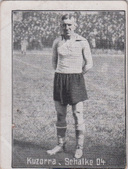
3eErnst Kuzorra (GER)
1926 Greiling.
Just like his brother-in-law, Fritz Szepan, Ernst Kuzorra spent his entire career with the German club Schalke 04. Kuzorra and Szepan led Schalke to six national championships between 1934 and 1942. He scored 265 goals in 350 official games for Schalke. Unofficially, Kuzorra is thought to have scored over 1,000 club goals, including friendlies. Kuzorra was very fit and played until age 45.
| 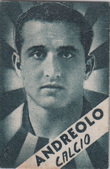
3fMichele Andreolo (URU/ITA)
1930s Produzione Sconosciuta.
Uruguay-born Italian footballer Michele Andreolo was an important component of Italy’s 1938 World Cup-winning squad. At the club level, Andreolo is most famous for his success with Bologna with which he won four Scudettos (Italian league titles).
| 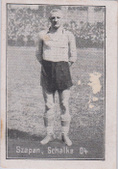
3gFritz Szepan (GER)
A highly skilled midfielder, Fritz Szepan won six national championships with FC Schalke 04. In 342 appearances, he scored 234 goals. Because of his extraordinary game understanding and leadership, Szepan was later known as “Beckenbauer before the war.”
|
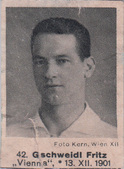
3hFritz Gschweidl (AUS)
1933 Idis Fussball-Schokolade.
Austrian inside right Fritz Gschweidl was one of the best prewar playmakers. He was very tall and strong with brilliant dribbling, excellent heading ability and a very strong shot. Due to his height, he was called "The Long Fritz." Playing for First Vienna FC, he won 5 Austrian League titles and three Austria Cups. Incredibly, the Long Fritz played for Vienna until age 45, appearing in 774 games for the club between 1924 and 1948.
| 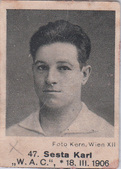
3iKarl Sesta (AUS)
1933 Idis Fussball-Schokolade.
A national champion wrestler, Karl Sesta was a strong tackler who struck fear in his opponents. He was capped 44 times for Austria, including starting for the “Wunderteam” at the 1934 World Cup. Sesta was one of the first modern defenders who would sometimes join in attacks.
| 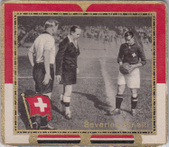
3jSeverino Minelli (SWI)
1938 Union König.
One of Switzerland’s most-capped players, Severino Minelli represented his national team 80 times, including starting at both the 1934 and 1938 World Cups. He won 5 Swiss league titles and 8 Swiss Cups with Grasshopper Club Zürich.
|
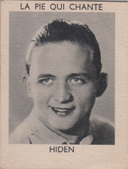
3kRudi Hiden (AUS/FRA)
1934 La Pie Qui Chante.
Rudi Hiden, a successful Austrian goalkeeper for Winer AC and the Wunderteam, was capped 20 times between 1928 and 1933. Herbert Chapman tried to recruit him to play for powerful Arsenal, however, the Football League in England blocked the signing. Instead, Hiden moved to France and helped RC Paris win one Division 1 title and three Coupes de France between 1935 and 1940.
| 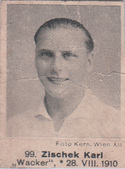
4aKarl Zischek, Karl (AUS)
1933 Idis Fussball-Schokolade.
Austria’s all-time best right winger, Karl Zischek was a fast player with excellent crossing shots. He was a key member of the “Wunderteam”, the Austrian national team that rose to international prominence in 1931. Scotland had never lost on mainland Europe, but Austria defeated Scotland 5-0 with Zischek scoring twice. Zischek played his entire career for the small suburban club, FC Admira Wacker Mödling, his crowning achievement coming in 1947 when he helped the club win both the league championship and Austria Cup.
| 
4bAngleo Schiavio (ITA)
1926 Editore Sconosciuto.
Striker Angelo Schiavio spent his entire career with Bologna. He led the club to Italian championships in 1925, 1929, 1936 and 1937. He was the top scorer in the league in the 1931-32 season, with 25 goals. For the italian national side, Schiavio scored 15 goals in 22 appearaces, including 4 goals in the 1928 Olympics and 4 goals in the 1934 World Cup. Schiavio went out on top – his very last game was the 1934 World Cup final match and he scored the game-winning goal in the 5th minute of extra time.
|
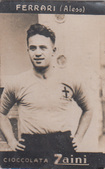
4cGiovani Ferrari (ITA)
1927 Cioccolato Zaini.
One of Italy’s greatest players, forward/midfielder Giovanni Ferrari won a record 8 Serie A championships: 5 with Juventus, 2 with Inter Milan and 1 with Bologna. He also was a member of the Italian national team that won both the 1934 and 1938 World Cups, and was capped a total of 44 times by his country. Ferrari excelled at building attacking plays and creating chances for his teammates, although he was himself a proficient scorer
| 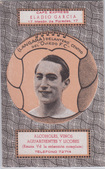
4dIsidro Lángara (SPA)
1932 Chocolates San.
A three-time Pichichi Trophy winner, Isidro Lángara was a scoring machine. With Real Oviedo, he scored 281 times in just 220 appearances as part of the famed “Delantera Eléctrica” forward line. His 60 goals in 32 games in 1933 is the highest single season goalscoring count for any Spanish-born player.
| 
4eBep Bakhuys (NED)
1932 Tiktak.
One of the most famous Dutch athletes of the 1930s, Dutch striker Elisa “Beb” Bakhuys was famous for his heading and precision shooting abilities. His most famous goal was a diving header he scored against Belgium in 1934, in fact his name is still synonymous with diving headers. Bakhuys left the Netherlands to play in France in 1937 after his amateur status was questioned. Bakhuys scored an impressive 28 goals in just 23 caps for the Dutch national side.
|
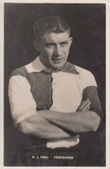
4fPuck Van Heel (NED)
1932 Bensdorp.
Dutch midfielder Puck van Heel earned 64 caps for the Dutch national team, a record not broken until 1979 (by Ruud Krol). He was a cornerstone of Feyenoord for which he captained the team and won five Dutch Eredivisie Championships between 1923 and 1929 (and was runner-up on four other occasions) as well as two KNVB Cups. Van Heel started for the Netherlands at the 1934 and 1938 World Cups.
| 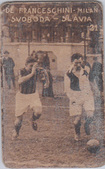
4gFrantišek Svoboda (CZE)
1926 Ediz Sconosciuta.
Forward František Svoboda was known for his rocket shot and good dribbling skills, and was a technically gifted player equally good in scoring and assisting. He won eight league titles with Slavia Prague and was the league’s top scorer in the 1934-35 season.
| 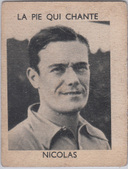
4hJean Nicolas (FRA)
1934 La Pie Qui Chante.
Jean Nicolas was a member of France’s 1934 and 1938 World Cup Squads. At the club level, the forward had an amazing strike rate, scoring 195 goals in just 159 matches between 1932 and 1939.
|
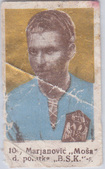
4iBlagoje"Mosa" Marjanović (YUG)
1939 Goal Candy.
"Moša" Marjanović, as he was known, was a skilled Serbian striker who amassed 575 goals in 14 seasons for his club, BSK, in the Yugoslavian league. He led Yugoslavia to third place at the 1930 World Cup. Moša could score from almost every position, scoring numerous goals with his back-heel, chest and sometimes even stomach.
| 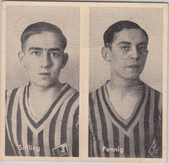
4jOtto Siffling (GER)
1931 Greiling.
Some pundits describe center forward Otto Siffling as the most talented German player ever and practically unstoppable. He could score from all angles, all distances, lob the keeper, score from penalty, from free kick, directly from corner and he was a great technician, dribbler, solid in heading abilities, and good at passing range especially long balls on the wing. Siffling started for the “Breslau Eleven”, the famous German national team that dominated its opponents in 1937. His level of play dropped off in 1938 and in the following year he suddenly died of Pleurisy at age 27. Despite only playing at a high level until age 25, Siffling still scored 17 goals in 31 games for the German national team.
| 
4kFrancisco Varallo (ARG)
1935 Leyes.
A member of Argentina’s World Cup team in 1930, Francisco Varallo led Boca Juniors to three Argentina league titles in the first half of the 1930s, as well as league runner-up in 1934 when he was the league’s top goal scorer with 34. Varallo is Boca Junior’s second all-time leading scorer in the professional era.
|
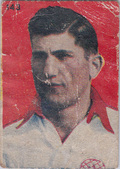
4lHerminio Masantonio (ARG)
1932 Chocolates Aguila.
Huracán center-forward Herminio Masantonio is the third highest goalscorer in Argentine football. He represented the Argentine national team at the 1935 and 1942 South American Championships and was the top scorer in both tournaments. In total, Masantonio scored 21 goals in 19 games for Argentina, a strike rate of more than one goal per game.
| 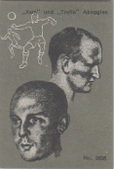
4mAndre Abegglen (SWI)
1937 Lindt Chocolates (w/Max Abegglen).
Considered Switzerland’s greatest footballer of all-time, forward André “Trello” Abegglen scored 240 career league goals in 318 appearances. In Switzerland, he won the league title in 1931 and the Swiss Cup 1927, 1932 and 1934. In France, he won league titles in 1935 and 1938, the Coupe de France 1937 and was the league’s top scorer in the 1934-1935 season with 30 goals in 28 games. Abegglen’s brother Max was also a great footballer. In 1944, Abegglen was manager of Swiss club, FC La Chaux-de-Fonds, when he died in a train accident while traveling with the team.
| 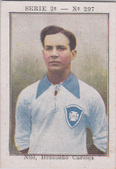
4nNilo Murtinho Braga (BRA)
1925 Dolar.
1920s Brazilian star Nilo won 6 Campeonatos Carioca between 1924 and 1935, including winning four consecutive times with Botafogo from 1932 to 1935. He was the top Campeonato Carioca goal scorer in 1924 (28 goals), 1927 (30 goals) and 1933 (19 goals). For the Brazilian national team, Nilo scored 11 goals in 19 appearances and started at the 1930 World Cup.
|

4oGéza Toldi (HUN)
1938 Camler’s Cigarettes.
Ferencváros striker Géza Toldi was a prolific scorer, scoring 430 goals in 458 career games with the club. He was the Hungarian league’s top scorer in the 1933-34 season, netting 27 goals. Toldi won four league titles and four Magyar Cups with Ferencváros. For the national side, Toldi scored 25 goals in 46 appearances.
| 
4pAleksandar Tirnanić (YUG)
1932 La Cigogne Cokolada (w/Planicka, named on back).
Aleksandar Tirnanić is credited with scoring 526 goals in 500 appearances in his club career. He was a key member of the Yugoslavian national team that finished fourth at the inaugural World Cup tournament in 1930. He later went on to manage the national team at the 1950 and 1954 World Cup tournaments as well as at the 1960 Olympics where Yugoslavia won the gold medal.
| 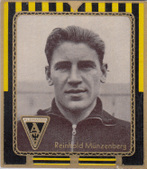
4qReinhold Münzenberg (GER)
1938 Union König.
One of Germany’s best prewar defenders, the English press praised Reinhold Münzenberg in 1935 for being “more 'English' than the English themselves.” Münzenberg teamed up with Paul Janes to form perhaps the best defensive duo of the late 1930s.
|
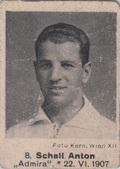
4rAnton Schall (AUS)
1933 Idis Fussball-Schokolade.
One of Austria’s greatest footballers, Toni Schall was the Austrian League top scorer on 5 occasions. His best season was 1927-28 in which he scored 36 goals in just 23 league games. Also an excellent passer, dribbler, Schall partnered with Adolf Vogl on both Admira Wien and the Austrian national team to score hundreds of goals.
| 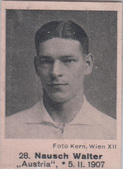
4sWalter Nausch (AUS)
1933 Idis Fussball-Schokolade.
Captain of the legendary Austrian "Wunderteam", played in almost all positions on the pitch but was mainly a left wing half. He earned 39 caps from the national team over the course of his career.
| 
4tEric Brook (ENG)
1930 Lambert & Butler.
Manchester City’s all-time scorer, Eric Brook led the club to an FA Cup in 1934 and the First Division championship in 1936. Brook was a muscular player with one of the fiercest shots in pre-war football.
|
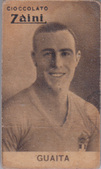
4uEnrique Guaita (ARG/ITA)
1932 Cioccolato Zaini.
Striker Enrique Guaita was one of twelve Argentines to play for both the Argentine and Italian national teams before the practice of playing for two national sides was banned. With Italy, he won the 1934 World Cup and scored the only goal against Austria in Italy’s semi-final match. With Argentina, he won the 1937 South American championships. At the domestic level, Guaita was the top scorer in Serie A in the 1934-35 season with 28 goals.
| 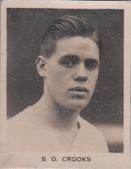
4vSammy Crooks (ENG)
1929 Topical Times.
Outside forward Sammy Crooks was a regular for the English national team in the 1930s, scoring 7 goals in 26 appearances in total. Crooks played 445 games for Derby County, lading them to two Second-place finishes in the Football League.
| 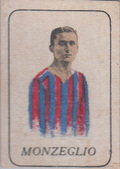
4wEraldo Monzeglio (ITA)
1930 Ediz Sconosciuto.
A member of both the 1934 and 1938 World Cup champion Italian national sides, defender Eraldo Monzeglio was named to the 1934 World Cup all-star team. With Bologna, he won Mitropa Cups in 1932 and 1934 as well as Serie A the 1928-29 season.
|
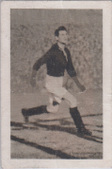
4xJosef Silný (CZE)
1933 ILSA Sweets.
Striker Josef Silný was a member of the 1934 Czechoslovakian side that finished second at the 1934 World Cup. Throughout his national team career, he scored 28 times in 50 matches. In his club career, he scored an amazing 375 goals in 379 matches in Czechoslovakian League.
| 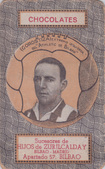
4yGuillermo Gorostiza (SPA)
1932 Chocolates Sans.
In 14 seasons playing for Athletic Bilbao and Valencia, forward Guillermo Gorostiza amassed 181 goals in 255 matches, while helping his clubs win 6 La Liga titles and 4 Copas Del Rey. Goroztiza was awarded the Pichichi Trophy in 1930 and 1932.
| 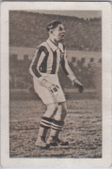
4zJaroslav Burgr (CZE)
1933 ILSA Sweets.
Jaroslav Burgr was one of the top defenders of the 1930s. With Sparta Prague he won 7 Czech league titles between 1927 and 1946. He was capped 57 times by the Czechoslovakia national side and started at the 1934 and 1938 World Cups.
|
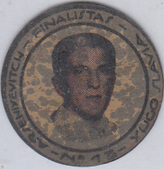
5aMilorad Arsenijević (YUG)
1930 Tinnie.
Capped 52 times by his country, Milorad Arsenijević was a key member of the national team that finished fourth at the inaugural World Cup tournament in 1930. He also served as the national team’s manager in the 1950 World Cup.
| 
4pWim Anderiesen (NED)
1932 Philips.
Dutch midfielder Wim Anderiesen played for Ajax for 15 seasons, winning 5 league titles between 1931 and 1939. He was capped 46 times by the national side and started for the Netherlands in both the 1934 and 1938 World Cups.
| |